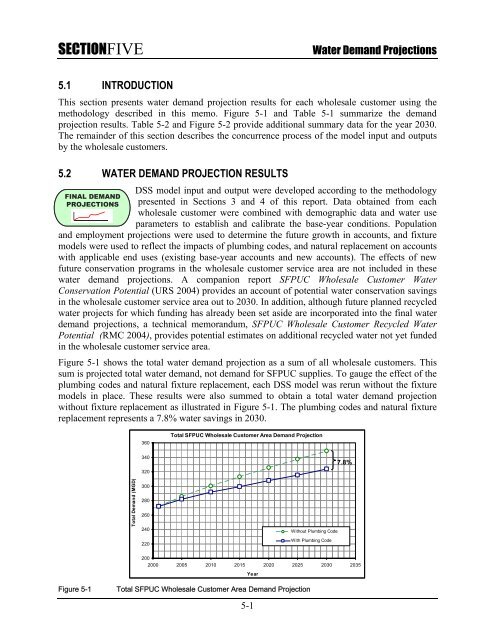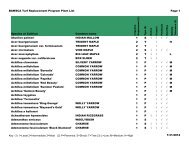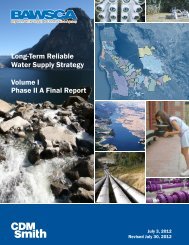SFPUC Wholesale Customer Water Demand Projections ... - BAWSCA
SFPUC Wholesale Customer Water Demand Projections ... - BAWSCA
SFPUC Wholesale Customer Water Demand Projections ... - BAWSCA
Create successful ePaper yourself
Turn your PDF publications into a flip-book with our unique Google optimized e-Paper software.
5. Section 5 FIVE <strong>Water</strong> <strong>Demand</strong> <strong>Projections</strong><br />
SECTIONFIVE<br />
<strong>Water</strong> <strong>Demand</strong> <strong>Projections</strong><br />
5.1 INTRODUCTION<br />
This section presents water demand projection results for each wholesale customer using the<br />
methodology described in this memo. Figure 5-1 and Table 5-1 summarize the demand<br />
projection results. Table 5-2 and Figure 5-2 provide additional summary data for the year 2030.<br />
The remainder of this section describes the concurrence process of the model input and outputs<br />
by the wholesale customers.<br />
5.2 WATER DEMAND PROJECTION RESULTS<br />
FINAL DEMAND<br />
PROJECTIONS<br />
DSS model input and output were developed according to the methodology<br />
presented in Sections 3 and 4 of this report. Data obtained from each<br />
wholesale customer were combined with demographic data and water use<br />
parameters to establish and calibrate the base-year conditions. Population<br />
and employment projections were used to determine the future growth in accounts, and fixture<br />
models were used to reflect the impacts of plumbing codes, and natural replacement on accounts<br />
with applicable end uses (existing base-year accounts and new accounts). The effects of new<br />
future conservation programs in the wholesale customer service area are not included in these<br />
water demand projections. A companion report <strong>SFPUC</strong> <strong>Wholesale</strong> <strong>Customer</strong> <strong>Water</strong><br />
Conservation Potential (URS 2004) provides an account of potential water conservation savings<br />
in the wholesale customer service area out to 2030. In addition, although future planned recycled<br />
water projects for which funding has already been set aside are incorporated into the final water<br />
demand projections, a technical memorandum, <strong>SFPUC</strong> <strong>Wholesale</strong> <strong>Customer</strong> Recycled <strong>Water</strong><br />
Potential (RMC 2004), provides potential estimates on additional recycled water not yet funded<br />
in the wholesale customer service area.<br />
Figure 5-1 shows the total water demand projection as a sum of all wholesale customers. This<br />
sum is projected total water demand, not demand for <strong>SFPUC</strong> supplies. To gauge the effect of the<br />
plumbing codes and natural fixture replacement, each DSS model was rerun without the fixture<br />
models in place. These results were also summed to obtain a total water demand projection<br />
without fixture replacement as illustrated in Figure 5-1. The plumbing codes and natural fixture<br />
replacement represents a 7.8% water savings in 2030.<br />
360<br />
Total <strong>SFPUC</strong> <strong>Wholesale</strong> <strong>Customer</strong> Area <strong>Demand</strong> Projection<br />
Total <strong>Demand</strong> (MGD)<br />
340<br />
320<br />
300<br />
280<br />
260<br />
240<br />
220<br />
Without Plumbing Code<br />
With Plumbing Code<br />
7.8%<br />
200<br />
2000 2005 2010 2015 2020 2025 2030 2035<br />
Year<br />
Figure 5-1<br />
Total <strong>SFPUC</strong> <strong>Wholesale</strong> <strong>Customer</strong> Area <strong>Demand</strong> Projection<br />
5-1







